Effect of the Pretreatment on the Properties of Cement-Based Recycled Powder
Abstract
1. Introduction
2. Experimental Program
2.1. Recycled Powder Preparation
2.2. Pretreatment Method
2.3. X-ray Diffraction (XRD)
2.4. Thermal Gravity (TG)
2.5. Fourier-Transform Infrared Spectroscopy (FTIR)
2.6. Scanning Electron Microscopy (SEM)
3. Results and Discussions
3.1. X-ray Diffraction (XRD) Analysis
3.2. Fourier-Transform Infrared Spectroscopy (FTIR) Analysis
3.3. Scanning Electron Microscope (SEM) Analysis
3.4. Thermal Gravity (TG) Analysis
3.5. Discussions
4. Effect of Source on Recycled Powder
5. Conclusions
- (1)
- CRP activity can be significantly enhanced through the pretreatment of calcination and the combined carbonation-calcination pretreatments. Therefore, these two pretreatment methods can be employed to augment the utilization rate of CRP.
- (2)
- The mineral components of the CRP decomposed gradually at different target temperatures during calcination. The primary minerals of the C-S-H gel, Ca(OH)2, and CaCO3 in the CRP decomposed into CaO after the calcination pretreatment. Based on the mineral composition analysis and microstructure characterization, the optimal thermal activation temperature was around 720–800 °C, generating an extensive quantity of the efficient reactive substance CaO that encourages the hydration reaction, which increased the reactivity of CRP.
- (3)
- The carbonization pretreatment consumed C-S-H gel, CaO, and Ca(OH)2 and produced CaCO3 in the CRP samples. The production of CaCO3 cannot enhance the activity, but it can improve the properties of CRP owing to the superior potency of CaCO3. Furthermore, the interfacial properties between CaCO3 and the C-S-H gel in the rehydration reaction developed a stronger bond due to silica gel, indicating that the carbonized CRP has a much stronger interface than that of un-pretreatment CRP. In addition, it seems that the threshold for carbonation time was 1d.
- (4)
- Both CaCO3 and CaO were found in the combined pretreated CRP, which demonstrated that the pre-carbonated product of CaCO3 displayed superior stability under high temperatures. The combined pretreatment method may have potential advantages over both the carbonation and calcination pretreatments. Nonetheless, future investigations into the impact of combined treatment on the CRP are necessary, with the ultimate goal of increasing the use of CRP.
- (5)
- The impact of the pretreatment on the CRP (obtained from cement past) was markedly superior to that on the RP (derived from CDW) due to the reduced impurity SiO2 content.
Author Contributions
Funding
Informed Consent Statement
Data Availability Statement
Conflicts of Interest
References
- Yang, S.; Yang, D.; Shi, W.; Deng, C.; Chen, C.; Feng, S. Global evaluation of carbon neutrality and peak carbon dioxide emissions: Current challenges and future outlook. Environ. Sci. Pollut. Res. 2023, 30, 81725–81744. [Google Scholar] [CrossRef]
- Wei, Y.; Chen, K.; Kang, J.; Chen, W.; Wang, X.; Zhang, X. Policy and Management of Carbon Peaking and Carbon Neutrality: A Literature Review. Engineering 2022, 14, 52–63. [Google Scholar] [CrossRef]
- Wang, Y.; Guo, C.; Chen, X.; Jia, L.; Guo, X.; Chen, R.; Zhang, M.; Chen, Z.; Wang, H. Carbon peak and carbon neutrality in China: Goals, implementation path and prospects. China Geol. 2021, 4, 720–746. [Google Scholar] [CrossRef]
- Huang, L.; Tan, J.; Huang, J.; Lu, Z.; Xie, J. Axial-impact resistance of geopolymeric recycled aggregate concrete confined with glass FRP tubes. J. Compos. Constr. 2024, 28, 04023071. [Google Scholar] [CrossRef]
- Bao, Z. Developing circularity of construction waste for a sustainable built environment in emerging economies: New insights from China. Dev. Built Environ. 2023, 13, 100107. [Google Scholar] [CrossRef]
- Yu, K.; Zhu, W.; Ding, Y.; Lu, Z.; Yu, J.; Xiao, J. Micro-structural and mechanical properties of ultra-high performance engineered cementitious composites (UHP-ECC) incorporation of recycled fine powder (RFP). Cem. Concr. Res. 2019, 124, 105813. [Google Scholar] [CrossRef]
- Soto-Paz, J.; Arroyo, O.; Torres-Guevara, L.E.; Brayan, A. Parra-Orobio, Miguel Casallas-Ojeda. The circular economy in the construction and demolition waste management: A comparative analysis in emerging and developed countries. J. Build. Eng. 2023, 78, 107724. [Google Scholar] [CrossRef]
- Chen, H.; Du, Q.; Huo, T.; Liu, P.; Cai, W.; Liu, B. Spatiotemporal patterns and driving mechanism of carbon emissions in China’s urban residential building sector. Energy 2023, 263, 126102. [Google Scholar] [CrossRef]
- Helena, D.; John, B.; Katja, L.; Timo, J.; Pirke, S.; Tuomas, M.; Susanna, S.; Tuuli, M.; Kaarina, S. Construction and demolition waste management—A holistic evaluation of environmental performance. J. Clean. Prod. 2015, 107, 333–341. [Google Scholar] [CrossRef]
- Gu, F.; Xie, J.; Vuye, C.; Wu, Y.; Zhang, J. Synthesis of geopolymer using alkaline activation of building-related construction and demolition wastes. J. Clean. Prod. 2023, 420, 138335. [Google Scholar] [CrossRef]
- Xie, J.; Li, J.; Zhang, B.; Chen, W.; Zhong, H.; Yang, J.; Feng, Y. Effects of pretreated recycled fine aggregates on the mechanical properties and microstructure of alkali-activated mortar. Case Stud. Constr. Mater. 2023, 20, e02819. [Google Scholar] [CrossRef]
- Ilcan, H.; Sahin, O.; Kul, A.; Ozcelikci, E.; Sahmaran, M. Rheological property and extrudability performance assessment of construction and demolition waste-based geopolymer mortars with varied testing protocols. Cem. Concr. Compos. 2023, 136, 104891. [Google Scholar] [CrossRef]
- Corbu, O.; Toma, I.O. Progress in sustainability and durability of concrete and mortar composites. Coatings 2022, 12, 1024. [Google Scholar] [CrossRef]
- Zhang, L.; Sojobi, A.O.; Kodur VK, R.; Liew, K.M. Effective utilization and recycling of mixed recycled aggregates for a greener environment. J. Clean. Prod. 2019, 236, 117600. [Google Scholar] [CrossRef]
- Malazdrewicz, S.; Ostrowski, K.A.; Sadowski, Ł. Self-compacting concrete with recycled coarse aggregates from concrete construction and demolition waste–Current state-of-the art and perspectives. Constr. Build. Mater. 2023, 370, 130702. [Google Scholar] [CrossRef]
- Robayo-Salazar, R.A.; Valencia-Saavedra, W.; Mejía de Gutiérrez, R. Construction and demolition waste (CDW) recycling—As both binder and aggregates—In alkali-activated materials: A novel re-use concept. Sustainability 2020, 12, 5775. [Google Scholar] [CrossRef]
- Tang, Q.; Ma, Z.; Wu, H.; Wang, W. The utilization of eco-friendly recycled powder from concrete and brick waste in new concrete: A critical review. Cem. Concr. Compos. 2020, 114, 103807. [Google Scholar] [CrossRef]
- Xiao, J.; Tang, Y.; Chen, H.; Zhang, H.; Xia, B. Effects of recycled aggregate combinations and recycled powder contents on fracture behavior of fully recycled aggregate concrete. J. Clean. Prod. 2022, 366, 132895. [Google Scholar] [CrossRef]
- Cantero, B.; Bravo, M.; de Brito, J.; Sáez del Bosque, I.F.; Medina, C. Thermal performance of concrete with recycled concrete powder as partial cement replacement and recycled CDW aggregate. Appl. Sci. 2020, 10, 4540. [Google Scholar] [CrossRef]
- Wu, H.; Zuo, J.; Zillante, G.; Wang, J.; Yuan, H. Status quo and future directions of construction and demolition waste research: A critical review. J. Clean. Prod. 2019, 240, 118163. [Google Scholar] [CrossRef]
- Zhang, B.; Feng, Y.; Xie, J.; Chen, W.; Xue, Z.; Zhao, G.; Li, Y.; Li, J.; Yang, J. Compressive behaviour and microstructures of concrete incorporating pretreated recycled powder/aggregates: The coupling effects of calcination and carbonization. J. Build. Eng. 2023, 68, 106158. [Google Scholar] [CrossRef]
- Gao, Y.; Cui, X.; Lu, N.; Hou, S.; He, Z.; Liang, C. Effect of recycled powders on the mechanical properties and durability of fully recycled fiber-reinforced mortar. J. Build. Eng. 2022, 45, 103574. [Google Scholar] [CrossRef]
- Feng, Y.; Li, J.; Zhang, B.; Fu, H.; Chen, W.; Xue, Z.; Lu, Z.; Yang, J.; Xie, J. Concrete improvement incorporating recycled powder and aggregates treated via a combination of calcination and carbonation: The impact behaviors. J. Clean. Prod. 2023, 48, 138069. [Google Scholar] [CrossRef]
- Xiao, J.; Ma, Z.; Sui, T.; Akbarnezhad, A.; Duan, Z. Mechanical properties of concrete mixed with recycled powder produced from construction and demolition waste. J. Clean. Prod. 2018, 188, 720–731. [Google Scholar] [CrossRef]
- Xu, J.; Kang, A.; Wu, Z.; Gong, Y.; Xiao, P. The effect of mechanical-thermal synergistic activation on the mechanical properties and microstructure of recycled powder geopolymer. J. Clean. Prod. 2021, 327, 129477. [Google Scholar] [CrossRef]
- Kazmi, S.M.S.; Munir, M.J.; Wu, Y.-F.; Patnaikuni, I.; Zhou, Y.; Xing, F. Influence of different treatment methods on the mechanical behavior of recycled aggregate concrete: A comparative study. Cem. Concr. Compos. 2019, 104, 103398. [Google Scholar] [CrossRef]
- Zhang, D.; Zhang, S.; Huang, B.; Yang, Q.; Li, J. Comparison of mechanical, chemical, and thermal activation methods on the utilisation of recycled concrete powder from construction and demolition waste. J. Build. Eng. 2022, 61, 105295. [Google Scholar] [CrossRef]
- Ouyang, K.; Shi, C.; Chu, H.; Guo, H.; Song, B.; Ding, Y.; Guan, X.; Zhu, J.; Zhang, H.; Wang, Y.; et al. An overview on the efficiency of different pretreatment techniques for recycled concrete aggregate. J. Clean. Prod. 2020, 263, 121264. [Google Scholar] [CrossRef]
- Du, J.; Zhang, T.; Chen, P.; Guo, Y.; Zhan, B.; Wei, J.; Yu, Q. Phase separation of recycled concrete powder during grinding and consequent influences on its hydration behaviors in cement paste. Cem. Concr. Compos. 2023, 142, 105203. [Google Scholar] [CrossRef]
- Zhang, B.; Feng, Y.; Xie, J.; Dai, J.; Chen, W.; Xue, Z.; Li, L.; Li, Y.; Li, J. Effects of pretreated recycled powder substitution on mechanical properties and microstructures of alkali-activated cement. Constr. Build. Mater. 2023, 406, 133360. [Google Scholar] [CrossRef]
- Xu, L.; Wang, J.; Li, K.; Lin, S.; Li, M.; Hao, T.; Ling, Z.; Xiang, D.; Wang, T. A systematic review of factors affecting properties of thermal-activated recycled cement. Resour. Conserv. Recycl. 2022, 185, 106432. [Google Scholar] [CrossRef]
- Wang, J.; Xu, L.; Li, M.; He, H.; Wang, Y.; Xiang, D.; Lin, S.; Zhong, Y.; Zhao, H. Effect of pre-carbonation on the properties of cement paste subjected to high temperatures. J. Build. Eng. 2022, 51, 104337. [Google Scholar] [CrossRef]
- Ouyang, X.; Wang, L.; Xu, S.; Ma, Y.; Ye, G. Surface characterization of carbonated recycled concrete fines and its effect on the rheology, hydration and strength development of cement paste. Cem. Concr. Compos. 2020, 114, 103809. [Google Scholar] [CrossRef]
- Wu, H.; Yang, D.; Ma, Z. Micro-structure, mechanical and transport properties of cementitious materials with high-volume waste concrete powder and thermal modification. Constr. Build. Mater. 2021, 313, 125477. [Google Scholar] [CrossRef]
- GB175-2007; Common Portland Cement. China Architecture and Building Press: Beijing, China, 2008.
- GBT50082-2009; Standard for Test Methods of Long-Term Performance and Durability of Oridinary Concrete. Ministy of Housing and Urban-Rural Developmengt of the People’s Republic of China: Beijing, China, 2010.
- Rocha, J.H.A.; Toledo Filho, R.D. The utilization of recycled concrete powder as supplementary cementitious material in cement-based materials: A systematic literature review. J. Build. Eng. 2023, 76, 107319. [Google Scholar] [CrossRef]
- Ma, Z.; Hu, R.; Yao, P.; Wang, C. Utilizing heat-mechanical synergistic treatment for separating concrete waste into high-quality recycled aggregate, active recycled powder and new concrete. J. Build. Eng. 2023, 68, 106161. [Google Scholar] [CrossRef]
- Khachani, M.; El Hamidi, A.; Halim, M.; Arsalane, S. Non-isothermal kinetic and thermodynamic studies of the dehydroxylation process of synthetic calcium hydroxide Ca(OH)2. J. Mater. Environ. Sci. 2014, 5, 615–624. [Google Scholar]
- Chen, Z.; Lee, Y.; Cho, H.; Lee, H.; Lim, S. Improvement in carbonation resistance of portland cement mortar incorporating γ-dicalcium silicate. Adv. Mater. Sci. Eng. 2019, 2019, 9856734. [Google Scholar] [CrossRef]
- Noor, M.S.M.; Afandi, N.N.A.M.; Noor, A.F.M.; Ismail, Y.M.B. Effect of Carbonate to Phosphate Molar Ratios on the physico-chemical properties of carbonated hydroxyapatite nanopowder. J. Eng. Sci. 2020, 16, 101–110. [Google Scholar] [CrossRef]
- Gallucci, E.; Zhang, X.; Scrivener, K.L. Effect of temperature on the microstructure of calcium silicate hydrate (CSH). Cem. Concr. Res. 2013, 53, 185–195. [Google Scholar] [CrossRef]
- Alonso, C.; Fernandez, L. Dehydration and rehydration processes of cement paste exposed to high temperature environments. J. Mater. Sci. 2004, 39, 3015–3024. [Google Scholar] [CrossRef]
- Vyšvařil, M.; Bayer, P.; Chromá, M.; Rovnaníková, P. Physico-mechanical and microstructural properties of rehydrated blended cement pastes. Constr. Build. Mater. 2014, 54, 413–420. [Google Scholar] [CrossRef]
- Hager, I. Behaviour of cement concrete at high temperature. Bull. Pol. Acad. Sci. Tech. Sci. 2013, 61, 145–154. [Google Scholar] [CrossRef]
- Pesce, C.; Ball, R.J.; Molinari, M.; Reeksting, S.; Pesce, G.L. Effects of carbohydrates and sulfonates during CaO hydration on portlandite microstructure. Cem. Concr. Res. 2024, 175, 107372. [Google Scholar] [CrossRef]
- Morandeau, A.; Thiéry, M.; Dangla, P. Investigation of the carbonation mechanism of CH and C-S-H in terms of kinetics, microstructure changes and moisture properties. Cem. Concr. Res. 2014, 56, 153–170. [Google Scholar] [CrossRef]
- Hu, X.; He, P.; Shi, C. Carbonate binders: Historic developments and perspectives. Cem. Concr. Res. 2024, 175, 107352. [Google Scholar] [CrossRef]
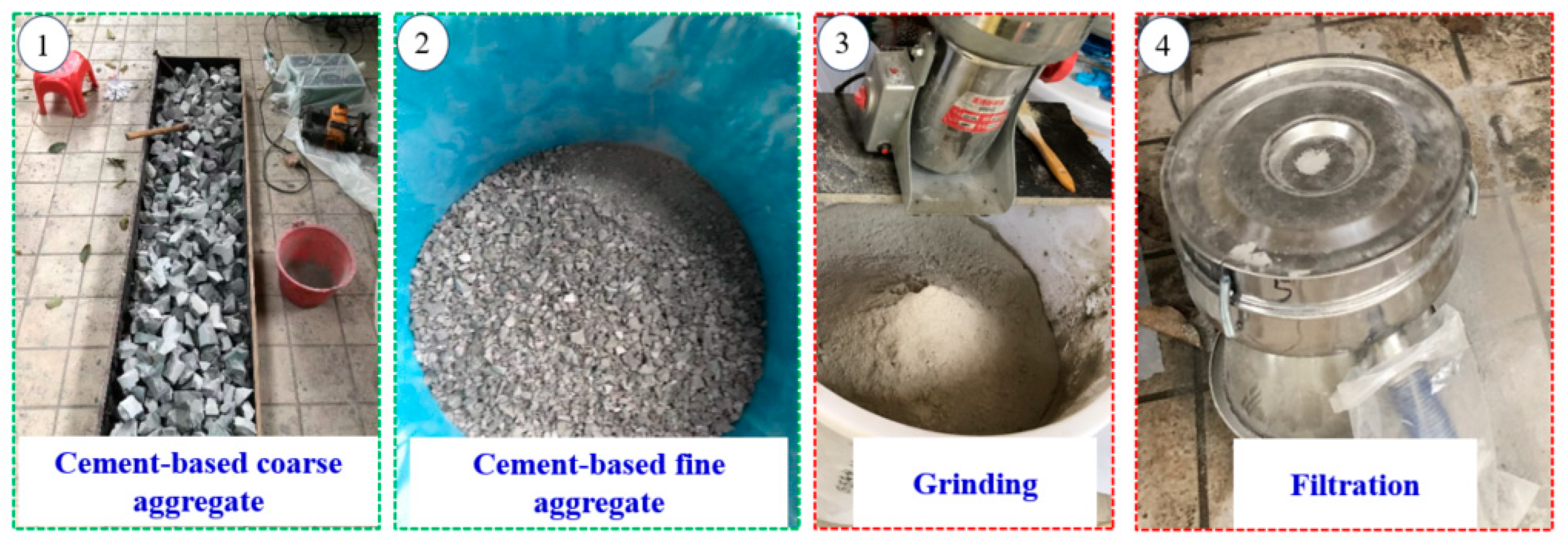
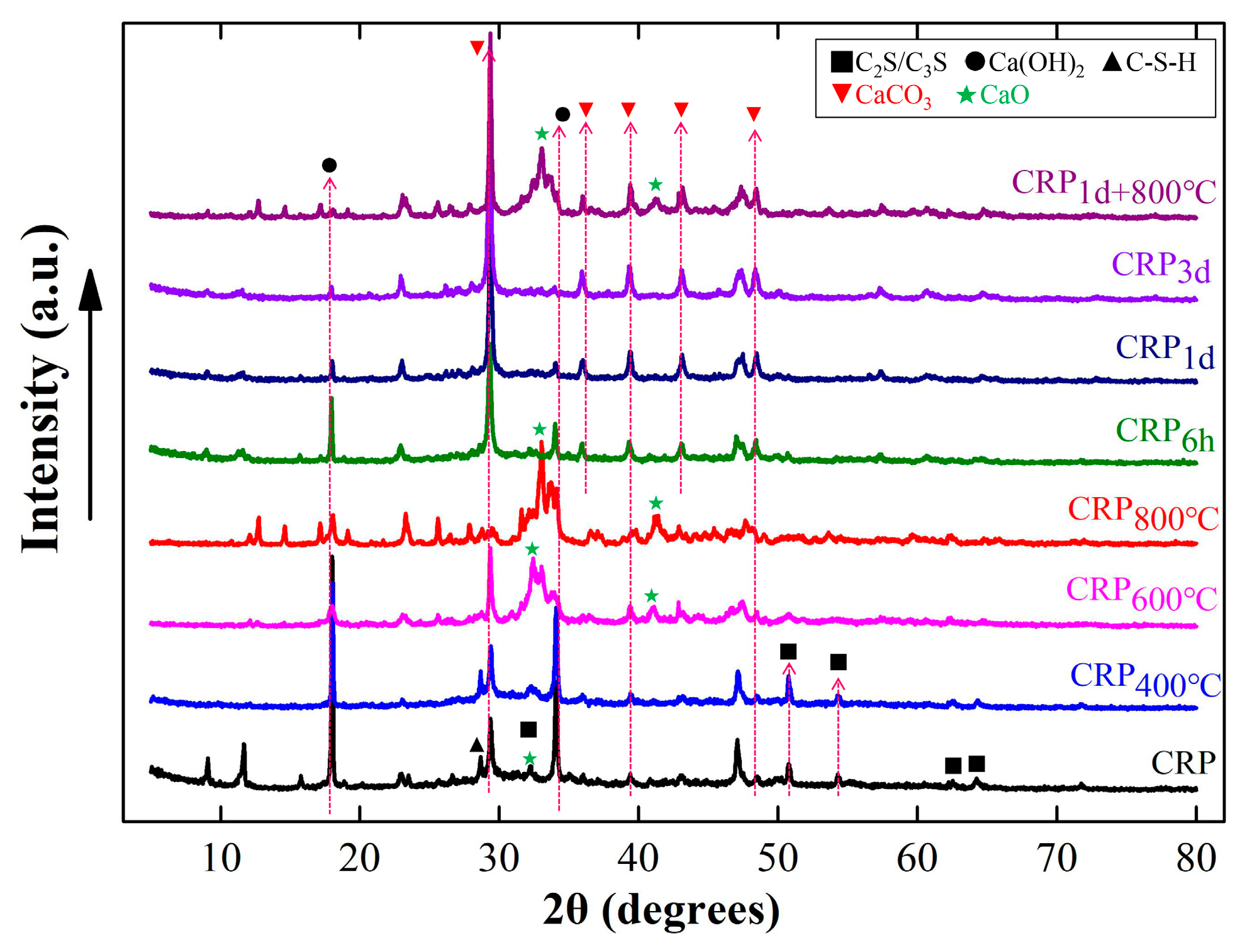
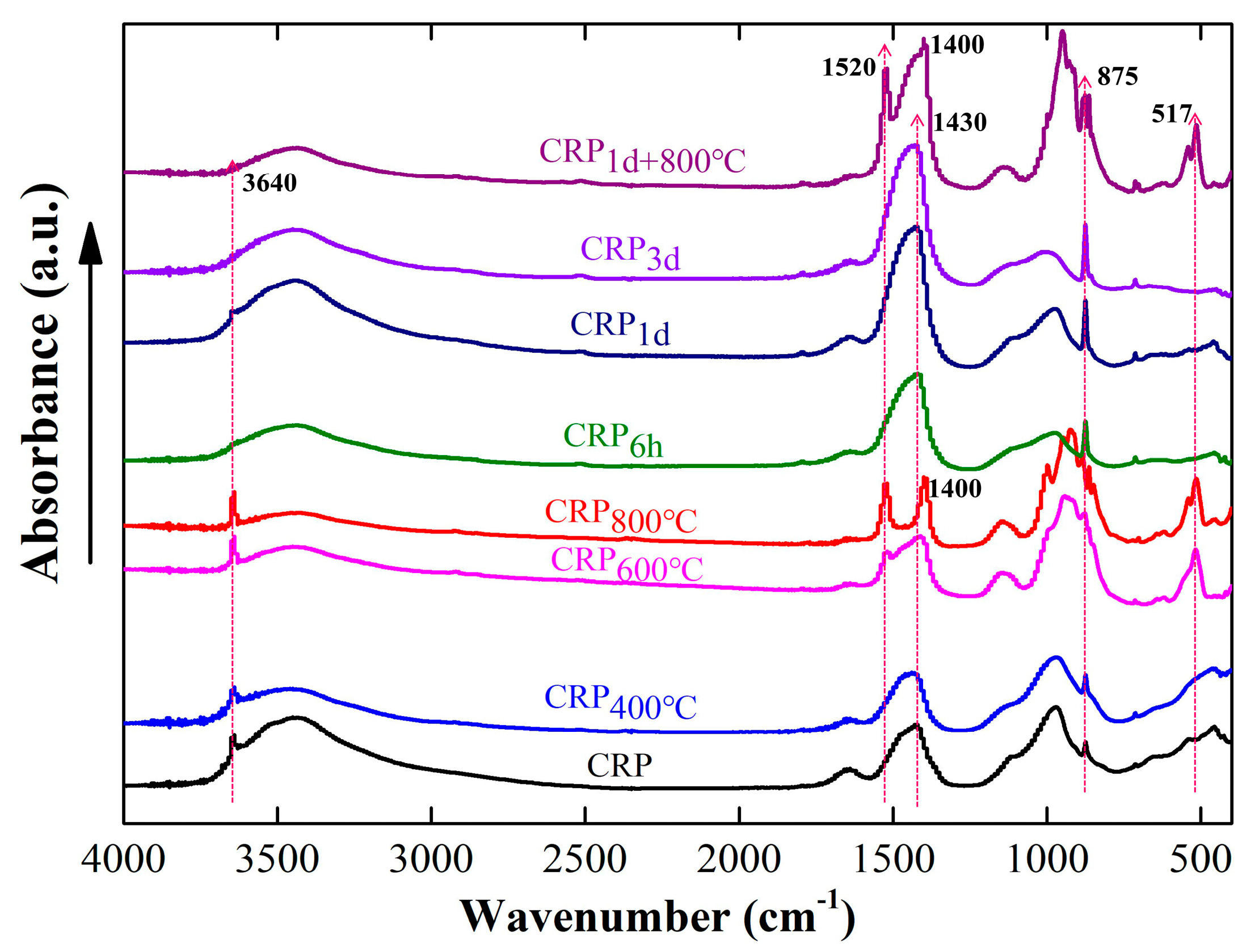

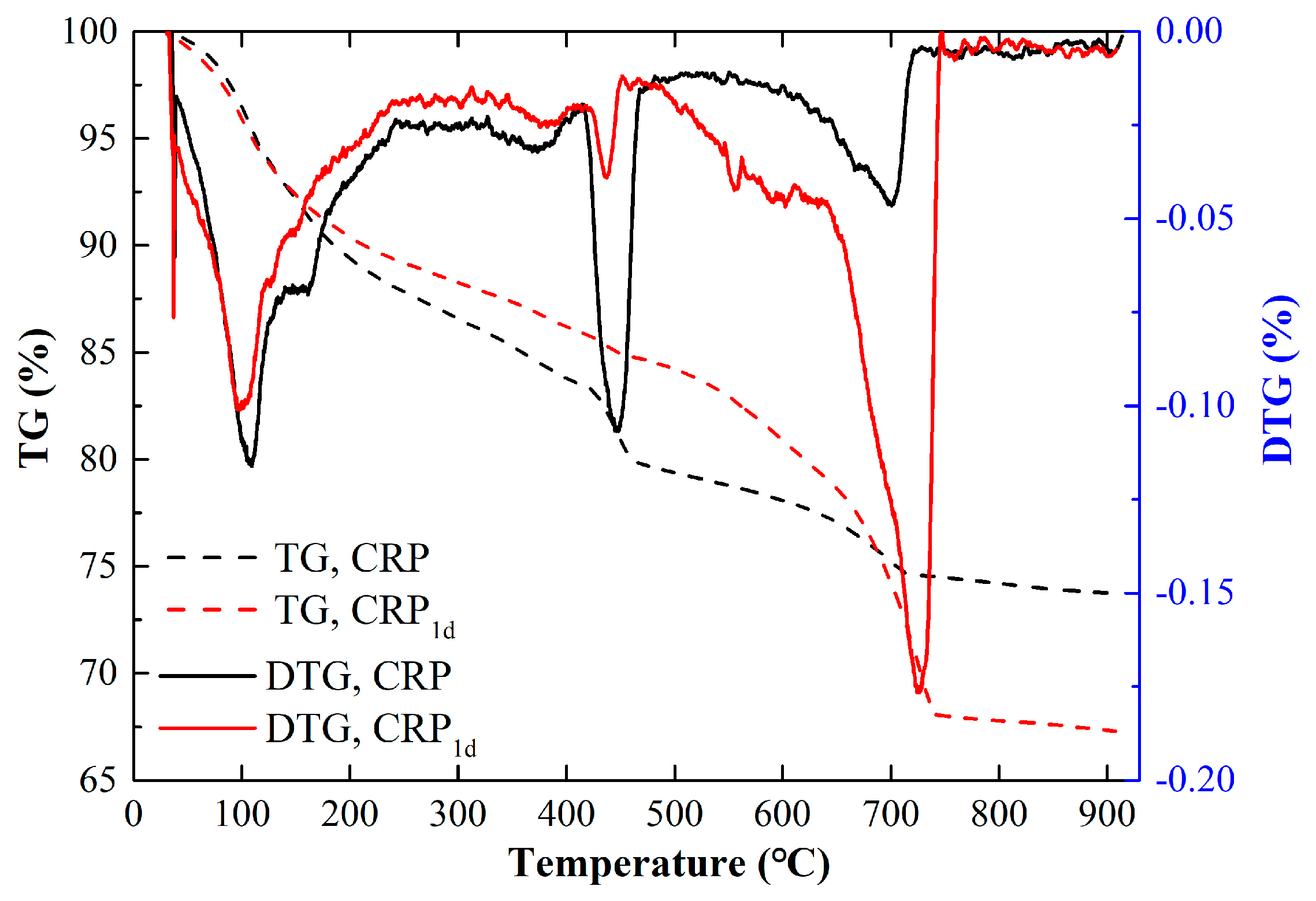
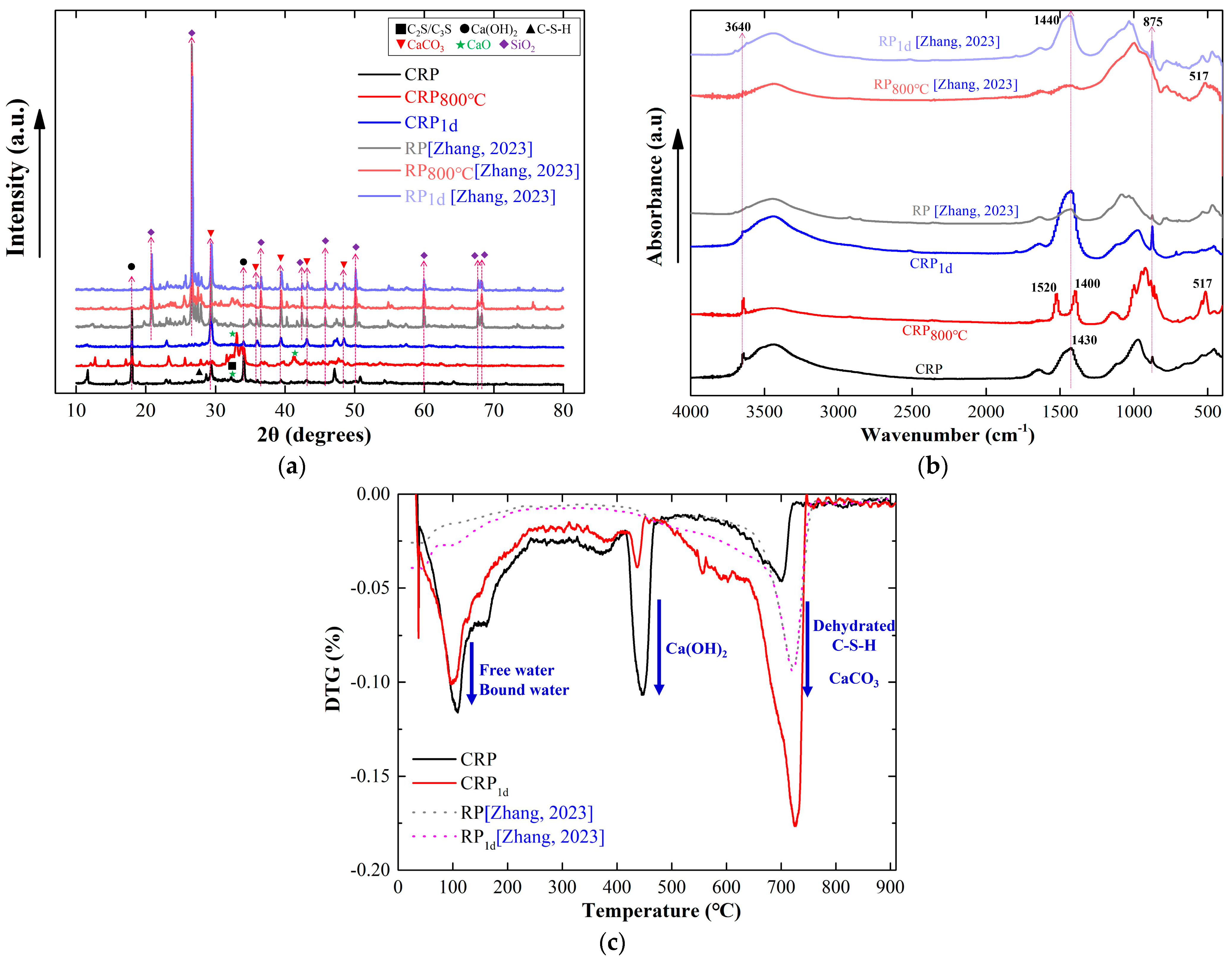
| CaO | SiO2 | Al2O3 | Fe2O3 | SO3 | Other |
|---|---|---|---|---|---|
| 65.12 | 20.41 | 6.54 | 3.27 | 3.35 | 1.31 |
| Simple ID | Pretreatment Method | Target Temperature of Thermal Treatment | Target Time of Carbonization Treatment |
|---|---|---|---|
| CRP | None | None | None |
| CRP400°C | calcination | 400 °C | None |
| CRP600°C | calcination | 600 °C | None |
| CRP800°C | calcination | 800 °C | None |
| CRP6h | carbonization | None | 6 h |
| CRP1d | carbonization | None | 1 day |
| CRP3d | carbonization | None | 3 days |
| CRP1d+800°C | carbonization–calcination | 800 °C | 1 d |
Disclaimer/Publisher’s Note: The statements, opinions and data contained in all publications are solely those of the individual author(s) and contributor(s) and not of MDPI and/or the editor(s). MDPI and/or the editor(s) disclaim responsibility for any injury to people or property resulting from any ideas, methods, instructions or products referred to in the content. |
© 2024 by the authors. Licensee MDPI, Basel, Switzerland. This article is an open access article distributed under the terms and conditions of the Creative Commons Attribution (CC BY) license (https://creativecommons.org/licenses/by/4.0/).
Share and Cite
Li, J.; Feng, Y.; Zhong, H.; Zhang, B.; Wang, J.; Zhang, B.; Xie, J. Effect of the Pretreatment on the Properties of Cement-Based Recycled Powder. Coatings 2024, 14, 107. https://doi.org/10.3390/coatings14010107
Li J, Feng Y, Zhong H, Zhang B, Wang J, Zhang B, Xie J. Effect of the Pretreatment on the Properties of Cement-Based Recycled Powder. Coatings. 2024; 14(1):107. https://doi.org/10.3390/coatings14010107
Chicago/Turabian StyleLi, Jianglin, Yuan Feng, Huaicheng Zhong, Baifa Zhang, Junjie Wang, Bin Zhang, and Jianhe Xie. 2024. "Effect of the Pretreatment on the Properties of Cement-Based Recycled Powder" Coatings 14, no. 1: 107. https://doi.org/10.3390/coatings14010107
APA StyleLi, J., Feng, Y., Zhong, H., Zhang, B., Wang, J., Zhang, B., & Xie, J. (2024). Effect of the Pretreatment on the Properties of Cement-Based Recycled Powder. Coatings, 14(1), 107. https://doi.org/10.3390/coatings14010107









